If you are tired of shoveling snow manually then the best thing you can do for yourself is to invest in a good snow blower. Usually, snow blowers come in three different categories; single-stage, two-stage, and three-stage. But what are the differences?
The first type of snow blower to hit the market was a single-stage machine. It revolutionized the way we clear snow, speeding up the process and making it easy for homeowners and businesses to clear away snow from their properties. Next came two-stage snow blowers and then three-stage snow blowers.
Table of Contents
- Single-Stage vs Two-Stage vs Three-Stage Snow Blowers
- Single-Stage vs Two Stage Snow Blowers
- Two Stage vs Three Stage Snow Blowers
- How Two-Stage & Three-Stage Machines Handle Snow Blowing Differently
- How Speed and Throw Distance Differ
- Differences In The Power Output
- Consider The User Experience & Maintenance Needs Before You decide
- Comparison Chart For The Top Two-Stage Snow Blowers
- Comparison Chart For The Top Two-Stage Snow Blowers
- Summary of single-stage vs two-stage vs three-stage snow blowers
Single-Stage vs Two-Stage vs Three-Stage Snow Blowers
The difference between the different stages is the amount of snow and type of snow they can move.
Let’s take a look at the key differences between single-stage, two-stage and three-stage snow blowers and what that means to you as a user.
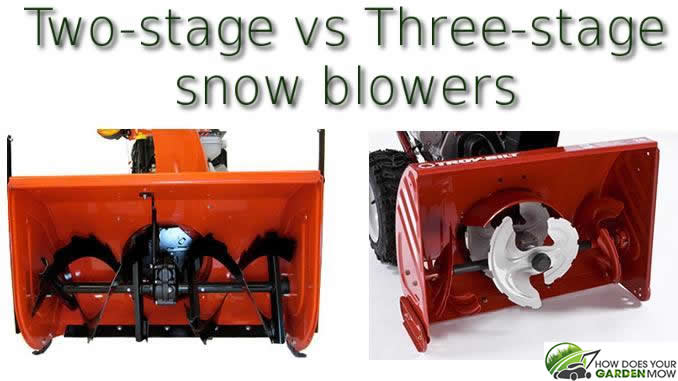 Now we’ll be mainly discussing the differences and similarities between two-stage and three-stage snow blowers.
Now we’ll be mainly discussing the differences and similarities between two-stage and three-stage snow blowers.
This way, you will know which type of machine you need and what you should expect from it.
But before we compare these two more modern snow blower types, it is important to have a brief understanding of single-stage snow blowers.
Single-Stage Snow Blowers
Single-stage snow blowers were the first mechanical snow blowers to hit the market.
Single-stage blowers are those that have augers (the visible blades at the front of the machine).
The auger usually makes direct contact with the ground scraping the snow up.
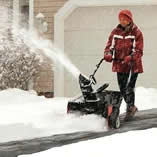 Single-stage machines also use the auger to blow the snow directly out via a chute.
Single-stage machines also use the auger to blow the snow directly out via a chute.
They are best used for residential jobs such as small paths and can handle light to medium snowfall as they can generally deal with about 8″ of snow or less.
They are usually fairly narrow lightweight machines, making them extremely easy to handle.
Single-stage snow blowers can be electrically powered, both corded and cordless, and also gas-powered.
These machines may seem like simple entry-level snow blowers but they really did change how snow was cleared.
They were a God-send for many people who live in areas that get frequent snowfall.
However, they were very restricted in their usage being unable to handle large snowfall and large areas.
They are also not very safe to use on gravel and dirt as the auger will scrape the ground and collect debris spreading this out with the snow.
They are also propelled through the user’s own power and can therefore be difficult, and sometimes impossible, to use on steep areas.
So in response to the consumer need for something that could handle jobs that the single-stage machines couldn’t, manufacturer’s designed a more powerful machine. Enter, the two-stage snow blower.
However, don’t dismiss these single-stage snow blower machines out of hand.
Many single-stage snow blowers have made in onto the list of the highest rated snow blowers along side the more powerful two-stage and three-stage machines.
Check single-stage snow blowers on Amazon
Two-Stage Snow Blowers
On a two-stage snow blower the auger collects the snow and breaks it into finer parts before it it is then sent to a central impeller.
Once there it then discharges the snow through the chute in a fan-like motion.
This action means that a two-stage snow blower can move the snow faster and usually blow it farther away than a single-stage machine can.
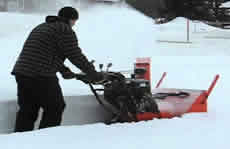 In addition the auger on a two-stage thrower does not make any contact with the ground. That means unlike the smaller machine it can be easily, effectively and safely used over gravel and dirt.
In addition the auger on a two-stage thrower does not make any contact with the ground. That means unlike the smaller machine it can be easily, effectively and safely used over gravel and dirt.
Two-stage snow blowers are heavier and more cumbersome than single-stage snow blowers, but almost always come with some type of self-propelled action.
This means in many cases they are actually easier to handle than a smaller single-stage blower.
In fact, the latest models practically drive themselves having a one-hand power-steering mechanism that frees up your other hand for working the controls.
Two-stage snow blowers can easily handle snow that is up to 32″ deep with some models being able to handle even deeper snow.
These machines are also considerably wider than the single-stage models. Thus can handle much larger areas and clear them a lot quicker than their little brothers.
Many can throw snow as far as 50 feet away.
Two-stage snow blowers are also gas-powered as they require much mower power than an electric engine can currently provide.
Although two-stage snow blowers are more powerful, easier to handle and get the job done quicker they still have some drawbacks.
These inherent drawbacks lead to the design and manufacture of three-stage machines.
Check the Top Two-Stage Snow Blowers on Amazon
Three-Stage Snow Blowers
Three-stage snow blowers are the latest type to hit the market and again came as an answer to the consumer need for a machine that could handle even tougher snow clearing jobs.
 Although two-stage snow blowers were a great step forward in mechanized snow clearing they still had some restrictions.
Although two-stage snow blowers were a great step forward in mechanized snow clearing they still had some restrictions.
Namely they can’t handle wet snow!
Three-stage machines were designed to offer all the benefits of a two-stage machine but with the added advantage of being able to clear away wet snow.
This is not to say that three-stage snow blowers are better than two-stage snow blowers, there are many two-stage models that are far superior to three-stage machines.
They just give the user extra functionality but usually at a cost (can not handle as deep snow as a two-stage).
Like two-stage machines three-stage snow blowers are also gas-powered as they require much mower power than an electric engine can currently provide.
Let’s look into these difference in a bit more detail.
Check the Top Three-Stage Snow Blowers on Amazon
Single-Stage vs Two Stage Snow Blowers
As I outlined in the article Best Lightweight Snow Blower single-stage snow blowers are perfect for small areas and for users who require a lightweight machine.
However, if you need to clear snow, or compacted ice, from an area or you just have a larger area that needs cleared then you will need a more powerful machine.
Single-stage snow blowers are great for most residential users that just want to clear the pavement in front of their home and their driveways.
For users that live in cold areas, or Canada, then a two-stage snow blower will make much lighter work of snow and ice clearing.
When it comes to the more powerful machines you will need to know whether you require a two-stage or three-stage snow blower.
Two Stage vs Three Stage Snow Blowers
Technically speaking two-stage and three-stage snow blowers are not actually snow blowers.
The term snow blower refers to a single-stage machine while the two-stage and three-stage machines are snow throwers.
However as with any living language the meaning of words in the English language change over time. Now the two terms are used interchangeably, even by the manufacturers’ technical and design departments.
So, what’s the main difference between the design of the two different stages?
Well, typically, the two-stage snow blower will clear the snow in two stages.
On the other hand, the 3-stage blower does its snow clearance in three stages.
So what does that mean and how does it affect you?
How Two-Stage & Three-Stage Machines Handle Snow Blowing Differently
The major difference between two-stage snow blowers and three-stage snow blowers, from a design point of view, lies in the snow blowing parts of these machines.
I mentioned earlier that a single-stage blower has one auger that throws the snow directly through a chute.
With a 2-stage blower there is a solid serrated auger and also an impeller.
The auger in the two-stage blower will grab the snow, and then feed it to the impeller.
After this, the impeller (which looks like a propeller) will throw the snow through the chute. The bigger the impeller, the more the snow it throws.
Two-stage snow blowers can usually handle snow as deep as 32″.
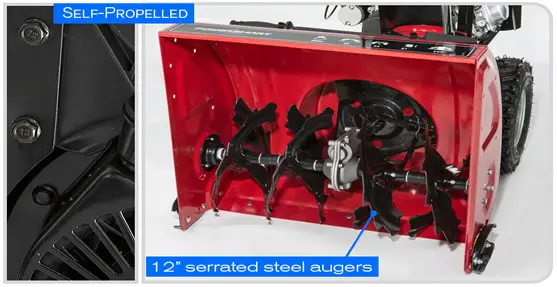
Conversely, a three-stage snow blower has more parts and snow blowing delivery.
A three-stage machine comes with a special auger, also known as an accelerator.
The accelerator moves 10 times faster than two-stage augers. It is also able to break up very heavy, icy, and wet snow and send it to the impeller which can handle that extra weight.
At this point, the impeller will push the snow through the chute.
In order to have this extra power and capability a three-stage machine will usually (but not always) have to compromise on the depth of snow it can handle with an average being 24″ deep.
The best three-stage snow blowers can handle any type of snow on any type of terrain.
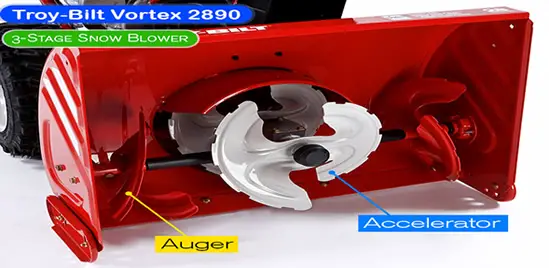
How Speed and Throw Distance Differ
These two blower types are very similar when it comes to snow removal.
First off, they are better, more powerful and a lot quicker than single-stage blowers.
Obviously, two-stage blowers remove the snow faster than single-stage blowers.
However, the three-stage blower is obviously the fastest of them all.
Thanks to the accelerator, the third auger on the three-stage snow blower, you can be sure of eliminating snow in the shortest time possible.
This accelerator is said to be able to push up snow 10 times faster than other regular machines.
In terms of the throwing distance, the two-stage blowers lose the battle as well.
However, there are some top quality 2-stage snow blowers that can match three-stage blowers for power and speed and throwing distance (though they can’t handle wet snow).
Typically, all two-stage blowers come with a variable throwing distance of between 24 feet to 50 feet.
Three-stage blowers have a general throwing distance of 50 feet (though due to its extra weight they usually throw snow about 24 feet).
Differences In The Power Output
Both these snow blower types are driven by gas engines as an electrical engine just won’t provide enough energy for these power-hungry machines.
Three-stage blowers tend to have a more powerful engine that delivers higher horsepower compared to the two-stage blowers.
Three-stage machines need this extra power to shift wet snow and ice which is heavier than normal snow.
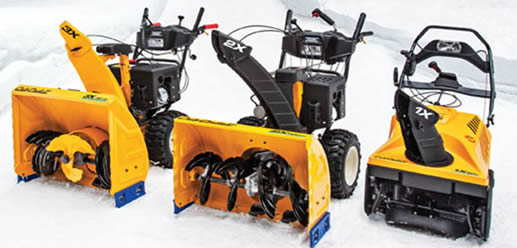
Consider The User Experience & Maintenance Needs Before You decide
Everyone wants a good-quality product.
Nonetheless, you can get a product that offers the best quality on the market but gives you a difficult time when using it.
Both modern two-stage and three-stage snow blowers deliver ease of use via one-handed control power steering.
Most of them are actually easier to handle than the much smaller and less powerful single-stage blowers.
Most of these two-stage and three-stage machines use a collection augers that push the snow to an impeller.
This means that you can throw a lot of snow per minute.
Both the blower types have self-propelling features meaning you don’t have to push the machine yourself to get it to move and with reverse gears you won’t have to pull the machine either.
One of these blowers is a “must-have” for people with steep sidewalks and/or driveways.
Most two-stage and three-stage blowers have special hand warmers embedded in their handles which is a neat modern touch.
Be aware that since they are gas-powered, an occasional check-up and oil change is needed to ensure the blower runs efficiently.
Three-stage snow blowers demand more when it comes to maintenance. They have an extra powerful engine that requires maintenance.
Most of the parts of a three-stage snow blower are more complex than the smaller machines, so if your machine develops a problem you may need to take it to a specialist to get fixed rather than trying to tinker with it yourself.
Long story short, it is generally more expensive to buy and then keep a three-stage blower well-maintained than it is for a two-stage blower.
Due to the massive engine, you should expect the three-stage blower to be louder than a three-stage snow blower in the same size category.
Comparison Chart For The Top Two-Stage Snow Blowers
Now that you have an understanding of the differences between single-stage, two-stage and three-stage snow blowers let’s look at our picks for the top snow blowers in each category.
Two-Stage Snow Blowers Comparison
| Product Name | Ariens 920022 Compact | Husqvarna ST224P | Troy-Bilt Arctic Storm | Poulan Pro PR241 |
| Engine | 208cc 4-Cycle OHV engine | 208cc Husqvarna engine | 357cc OHV engine | 208cc Poulan PRO engine |
| Start System | Electric w/recoil | Electric w/recoil | Electric w/recoil | Electric |
| Throwing Distance | 40 feet | 35 feet | 30 feet | 45 feet |
| Clearing Width | 24 inches | 24 inches | 30 inches | 24 inches |
| Clearing Depth | 20 inches | 23 inches | 23 inches | 23 inches |
| Chute Rotation | 200 degrees | 180 degrees | 200 degrees | 180 degrees |
| Warranty | 90-Day commercial warranty, and 3-year residential warranty | 5-years engine warranty, 3-year residential warranty | 5-year limited warranty | 4-year engine warranty, 2-year limited warranty |
| Price | Check Price |
Check Price |
Check Price |
Check Price |
All of the above two-stage snow blowers come with heated handles, remote control chute, 6 forward/2 reverse gears, and LED headlight to let you use them even in the dark.
Comparison Chart For The Top Two-Stage Snow Blowers
Three-Stage Snow Blowers Comparison
| Product Name | 3-Stage (riding mower attachment) | CUB CADET HD 3-Stage | Cub Cadet 3X 26 | Troy-Bilt Vortex |
| Engine | Needs attached to riding mower | 357cc Cub Cadet OHV Engine | 357cc OHV Engine | 277cc 4-cycle OHV |
| Clearing Width | 42 inches | 28 inches | 26 inches | 24 inches |
| Clearing Depth | 18 inches | 18 inches | 21 inches | 21 inches |
| Chute Rotation | 200 degrees | 200 degrees | 190 degrees | 200 degrees |
| Warranty | 3 years limited warranty | 3 years limited warranty | 3 years limited warranty | 2 years limited warranty |
| Price | Check Price |
Check Price |
Check Price |
Check Price |
Be aware that the first three-stage snow blower in the above chart is not a stand-alone unit but is in fact an attachment for a riding lawn mower. It is a best fit for the Cub Cadet XT1 and XT2 lawn tractors.
The CUB CADET HD three-Stage Snow Blower comes with a free canopy for extra security and product durability.
All 4 three-stage snow blowers have six forward and 2 reverse gears.
Summary of single-stage vs two-stage vs three-stage snow blowers
So, which is the right snow blower to choose? Do you need a single-stage, a two-stage or three-stage snow blower?
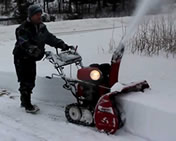 Honestly, it depends on where you live and how you intend to use it.
Honestly, it depends on where you live and how you intend to use it.
For most common residential needs a cheap lightweight single-stage snow blower will suffice.
However, for thick and hard snowfall, either a two-stage or a three-stage blower will do a great job.
Likewise, if you have large and/or steep areas to clear then you will need a machine with a lot of power and a wide clearing area and again either machine will do a great job.
However, if you regularly have to clear very compacted ice-packed snow and/or wet snow then you will need to opt for a three-stage snow blower.
Alternatively if you have very heavy snowfall that is usually deeper than 24″ then you may want to go for a two-stage snow blower instead.
Also, keep in mind that for the most part three-stage snow blowers are faster. They can also handle heavier snow but they are not always the best option if you don’t need that extra functionality.

